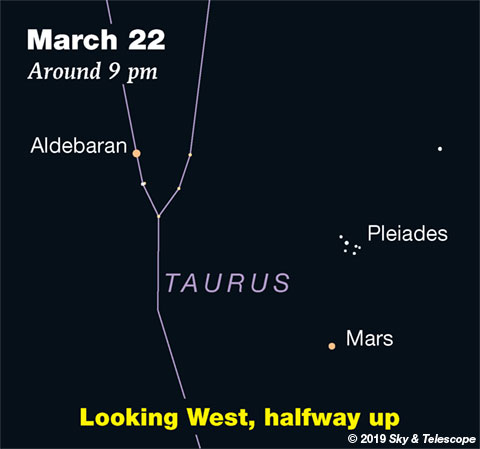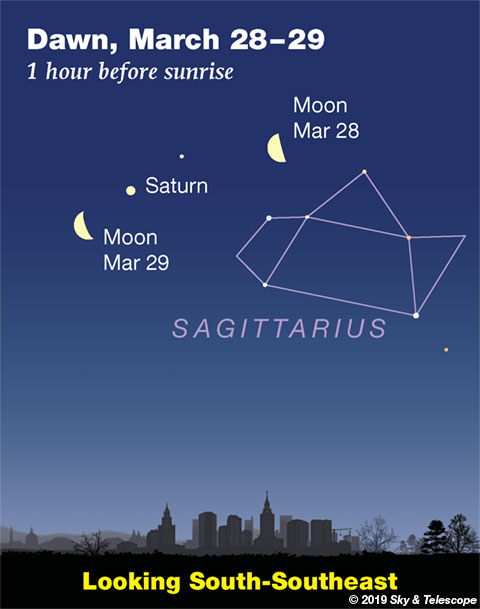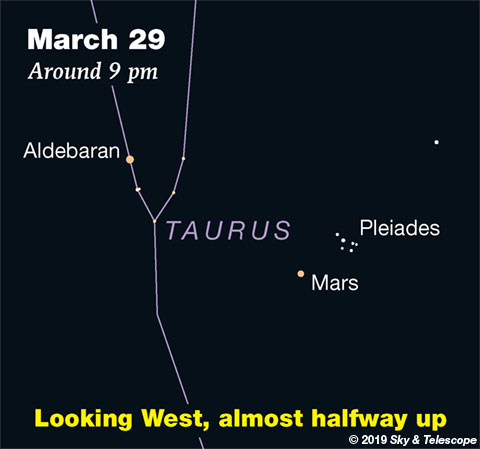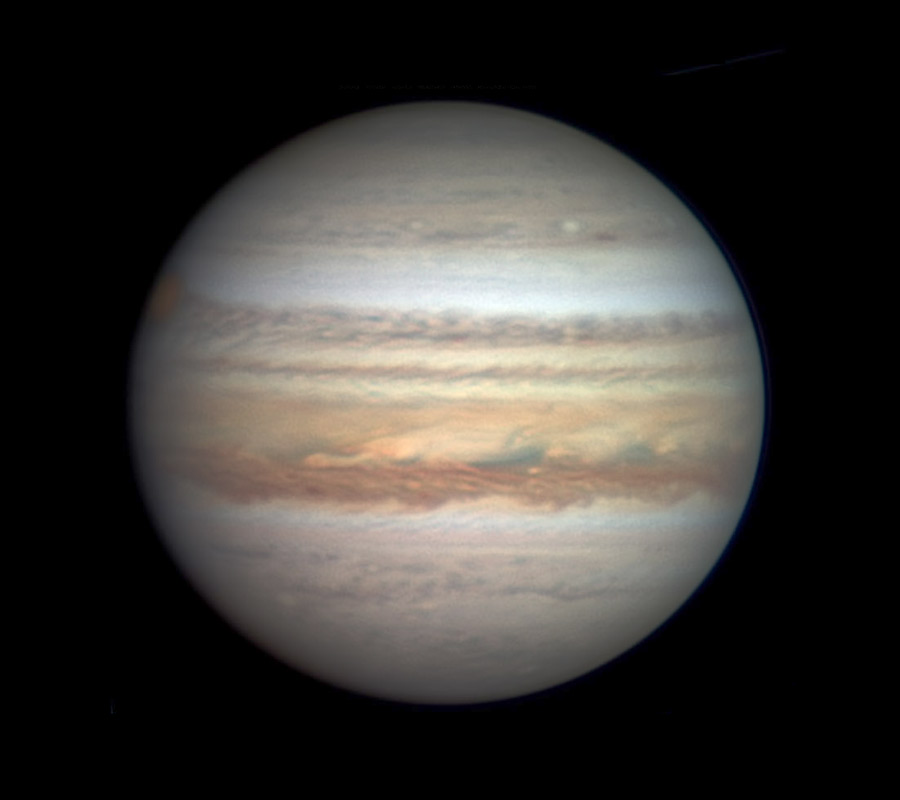
Friday, March 22
• Immediately after dark, Sirius shines brilliantly in the south-southwest before the rise of the waning gibbous Moon (for most of North America). Lower left of Sirius, by about a fist at arm's length, is the triangle of Adhara, Wezen, and slightly fainter Aludra, counting from right to left. They form Canis Major's hind foot, rear end, and tail tip, respectively.
Just upper left of Aludra, forming a 3rd- and 4th-magnitude arc 7° long, are the three uppermost stars of the constellation Puppis. No, it's not a puppy, despite following right behind the Big Dog. It's the Poop Deck (stern) of the giant ancient constellation Argo Navis, the ship of Jason and the Argonauts. These three stars are the only stars of Argo readily visible naked-eye from mid-northern latitudes.
And just 1.4° upper right of the middle one, a small scope or good binoculars will show the 6th-magnitude open cluster M93. Look for before the Moon rises and lights the sky! See the story of M93 in the March Sky & Telescope, page 48.
Saturday, March 23
• Once the waning gibbous Moon is well up in the southeast very late this evening, use binoculars to help pick out Beta and Alpha Librae, both about 3rd magnitude, to its left and right respectively. They're each about 4° or 5° from the Moon.
Alpha (Zubenelgenubi) is a wide double star for binoculars: magnitudes 2.8 and 5.1, separation 4 arcminutes. The fainter component is now above or upper right of the brighter one.
Sunday, March 24
• This is the time of year when Orion declines in the southwest after dark, with his Belt roughly horizontal. When does Orion's Belt appear exactly horizontal? That depends on where you're located east-west in your time zone, and also on your latitude.
Can you time this event? If you're near your time zone's standard longitude, expect it around 9 this evening (daylight-saving time). . . more or less.
Monday, March 25
• This is the also time of year when the dim Little Dipper juts to the right from Polaris (the Little Dipper's handle-end) during late evening. The much brighter Big Dipper curls over high above it by then, "dumping water" into it. They do the reverse water dump on fall evenings.
Tuesday, March 26
• Before and during tomorrow morning the 27th, you'll find the Moon shining near Jupiter.

Wednesday, March 27
• Last-quarter Moon tonight (exactly so at 12:10 a.m. Thursday morning EDT). The Moon rises around 2 or 3 a.m. local daylight time Thursday morning. Before dawn, look for Jupiter off to its upper right and dimmer Saturn roughly half that far to its lower left.
And very early before the sky gets too bright, look for the Sagittarius Teapot resting upright at the Moon's lower right.
Thursday, March 28
• The signature fall-and-winter constellation Cassiopeia retreats down after dark. Look for it fairly low in the north-northwest. It's standing roughly on end.
But for skywatchers at mid-northern latitudes Cassiopeia is circumpolar, never going away completely. By midnight or 1 a.m. it's at its lowest due north, lying not quite horizontally.

Friday, March 29
• In the western sky after dusk, spot orange Mars passing just 3° from the delicate, blue-white Pleiades this evening through Sunday evening.
Saturday, March 30
• Castor and Pollux shine together very high in the south after dusk. Pollux is slightly the brighter of these "twins." Draw a line from Castor through Pollux, follow it farther lower left by a big 26° (about 2½ fist-widths at arm's length), and you're at the dim head of Hydra, the Sea Serpent. In a dark sky it's a subtle but distinctive star grouping, about the size of your thumb at arm's length. Binoculars show it easily through light pollution.
Continue the line farther by another fist and a half and you hit Alphard, Hydra's 2nd-magnitude orange heart.
Another way to find the head of Hydra: It's almost midway from Procyon to Regulus.
________________________
Want to become a better astronomer? Learn your way around the constellations. They're the key to locating everything fainter and deeper to hunt with binoculars or a telescope.
This is an outdoor nature hobby. For an easy-to-use constellation guide covering the whole evening sky, use the big monthly map in the center of each issue of Sky & Telescope, the essential guide to astronomy.

Once you get a telescope, to put it to good use you'll need a detailed, large-scale sky atlas (set of charts). The basic standard is the Pocket Sky Atlas (in either the original or Jumbo Edition), which shows stars to magnitude 7.6.
Next up is the larger and deeper Sky Atlas 2000.0, plotting stars to magnitude 8.5; nearly three times as many. The next up, once you know your way around, are the even larger Interstellarum atlas (stars to magnitude 9.5) and Uranometria 2000.0 (stars to magnitude 9.75). And read how to use sky charts with a telescope.
You'll also want a good deep-sky guidebook, such as Sue French's Deep-Sky Wonders collection (which includes its own charts), Sky Atlas 2000.0 Companion by Strong and Sinnott, or the bigger Night Sky Observer's Guide by Kepple and Sanner.
Can a computerized telescope replace charts? Not for beginners, I don't think, and not on mounts and tripods that are less than top-quality mechanically (meaning heavy and expensive). And as Terence Dickinson and Alan Dyer say in their Backyard Astronomer's Guide, "A full appreciation of the universe cannot come without developing the skills to find things in the sky and understanding how the sky works. This knowledge comes only by spending time under the stars with star maps in hand."
Mercury is hidden in the glow of sunrise.
Venus (magnitude –4.0) rises above the east-southeast horizon around the first light of dawn. Look for it about 65° lower left of Jupiter.
Mars (magnitude +1.4, in Taurus) glows in the west after dusk. It's the orange-red spark below or lower right of the Pleiades this week. The Pleiades edge closer to Mars every day and pass it by 3° March 29–31.
Mars this season is about as far from us as it ever gets; in a telescope it's a pathetic little blob less than 5 arcseconds wide.

Jupiter (magnitude –2.2, in the feet of Ophiuchus) rises in the southeast around 2 a.m. daylight-saving time. It's high in the south just as dawn begins to brighten, the best time to observe it telescopically. The farther south you are, the higher it will be.
Orange Antares sparkles 15° to Jupiter's upper right when the planet rises, and directly right of it by the beginning of dawn.
Saturn (magnitude +0.6, in Sagittarius) glows in early dawn, to the lower right of Jupiter by 25°.
Uranus sets in the west shortly after dark.
Neptune is out of sight low in the glow of dawn.
______________________
All descriptions that relate to your horizon — including the words up, down, right, and left — are written for the world's mid-northern latitudes. Descriptions that also depend on longitude (mainly Moon positions) are for North America.
Eastern Daylight Time (EDT) is Universal Time (UT or GMT) minus 4 hours.
______________________
Audio sky tour. Out under the evening sky with your earbuds in place, listen to Kelly Beatty's monthly podcast tour of the heavens above. It's free.
______________________
"Science is built up of facts, as a house is with stones. But a collection of facts is no more a science than a heap of stones is a house."
— Henri Poincaré (1854–1912)
______________________
 3
3








Comments
Rod
March 22, 2019 at 10:12 am
The view of Jupiter from the Celestron C14 shown in the report for 19-Mar-19 is very good. I was out in Maryland that morning too viewing Jupiter near 0600 local time using my 90-mm refractor. "Jupiter 99.13% illuminated. Using the 14-mm eyepiece at 71x and 1-degree true field of view. I could see multiple cloud bands on Jupiter and the 4 Galilean moons. All four on left side, mirror reverse image and three in triangle pattern close together." Short note from my stargazing log. This morning I enjoyed some solar observing using white light solar filter. Sunspot AR2736 has erupted and very large area now, more than 100,000 km size or some 2.5' size based upon the Sun's distance from Earth this morning. It was windy with rapid moving lower level clouds so I kept my 90-mm configuration lean and mean viewing at 31x 🙂
You must be logged in to post a comment.
Rod
March 27, 2019 at 8:24 am
Hope folks enjoyed the morning sky near 0600 EDT today. The waning gibbous Moon was in Sagittarius and Jupiter was close to 4 degrees away (right of the Moon) in Ophiuchus, both near 28 degrees altitude in south sky near 0600 EDT for my location in Maryland. A very nice sight greeting early birds Last night was great stargazing before the Moon rose after mid-night. I was out from 2200-2330 EDT or 10:00 PM until 11:30 PM. Great views of 7 galaxies in Leo using my 10-inch telescope (Newtonian on Dob). M65, M66, NGC 3628, M95, M96, M105, and NGC 3384. I viewed these galaxies near 35x and 1.8 degree true field of view. All 7 galaxies easy to see in the larger telescope (compared to my 90-mm refractor) and NGC 3384 close to 10.8 apparent magnitude, faint target. Most of the galaxies are some 30E+6 light-years distance from Earth. My favorite target last night was M3 globular cluster in Canes Venatici. The 10-inch telescope at 86x view, nicely resolved the halo stars with bright core or center. Lovely view in the eyepiece at 86x and close to 0.84 degree true field of view in the eyepiece. Earth's rotation quite obvious while viewing M3. I had to adjust periodically to keep M3 centered for a good view in the eyepiece otherwise M3 moved across the field of view. Polaris multiple star system stationary. M3 is a globular cluster some 33,900 light-years distance from Earth. Telescopes and sensitive measurements using telescopes show these star systems orbit the center of the Milky Way galaxy - not the Earth
You must be logged in to post a comment.
Rod
March 29, 2019 at 8:26 am
mary beth, any stargazing reports lately?
You must be logged in to post a comment.
You must be logged in to post a comment.